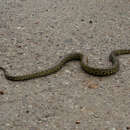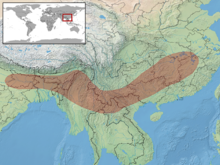fr
noms dans le fil d’Ariane


Trimeresurus (sensu lato) includes more than 40 species occurring in southern, eastern, and southeastern Asia. The group includes species occurring in a wide range of habitats, lifestyles (terrestrial, semi-arboreal, and arboreal), and reproductive modes (oviparous and ovoviviparous).A number of these species have been segregated into new genera (e.g., Ovophis, Protobothrops, Viridovipera). Guo and Zhao (2006) undertook an analysis of skull morphology of nine Asian pit vipers, including Protobothrops jerdonii). (Guo and Zhao 2006 and references therein)
The genus Protobothrops was described to accommodate two species previously placed in the genus Trimeresurus, T. jerdonii and T. mucrosquamatus. In their 2007 revision, Guo et al. placed 10 species in this genus.
The dangerously venomous Protobothrops jerdonii is among the most widespread and abundant pitvipers in Asia, occurring predominantly in China, but also in adjoining countries, including Vietnam, India, Myanmar and Nepal. These snakes are typically found at elevations of ~2000m. (Guo et al. 2011 and references therein) Another nominal Protobothrops species, P. xiangchengensis, appears actually to be nested within P. jerdonii, although Guo et al. (2007) considered it to be a valid species sister to P. jerdonii. (Guo et al. 2009).
Accotding to Leviton et al. (2003), this species occurs in Myanmar (Chin State [Chin Hills] and Kachin State), India (Assam), and China (Yunnan, Szechwan, Hupeh). In Myanmar and adjacent Yunnan, this species has been recorded from elevations of 1442 m to just under 2300m. In Nepal, it has been recorded as high as 2800 m. Historical records from Chin Hills and Kachin State as well as more recent records from Kachin State place this species in montane (Chin Hills-Rakhine-Yoma) and temperate (Northern Triangle) forests. Individuals have been found in shifting cultivation and in some regions this species has been reported to be commonly found along rocky streams in trees and shrubs and under rocks.
Levitin et al (2003) discuss interesting geographic variation reported in the literature for ventral and subcaudal scale counts and suggest that these patterns indicate the need for further study of populations in Myanmar, India, and southwestern China.
Huan, X. et al. (2013) sequenced the complete mitochondrial genome of Protobothrops jerdonii.
Leviton et al. (2003) provide a technical description of Protobothrops jerdonii: Scales in 21 longitudinal rows at midbody (rarely 23); snout length a little more than twice diameter of eye; head above, except for large internasals and supraoculars, covered by small, unequal, smooth scales that are feebly imbricate or juxtaposed; first labial completely separated from nasal by a suture; internasals separated by 1-2 small scales, 6-9 small scales in line between supraoculars; 7-8 upper labials, third and fourth beneath eye, in contact with subocular or separated by at most a single series of small scales; ventrals: males 164-188, females 167-193; subcaudals: males 50-78, females 44-76. Total length: males 835 mm, females 990 mm; tail length: males 140 mm, females 160 mm.
(Leviton et al. 2003 and references therein)
Protobothrops jerdonii Protobothrops generoko animalia da. Narrastien barruko Viperidae familian sailkatuta dago.
Protobothrops jerdonii Protobothrops generoko animalia da. Narrastien barruko Viperidae familian sailkatuta dago.
Protobothrops jerdonii est une espèce de serpents de la famille des Viperidae[1].
Cette espèce se rencontre[1] :
C'est un serpent venimeux vivipare[1].
Selon Reptarium Reptile Database (19 février 2014)[2] :
Cette espèce est nommée en l'honneur du naturaliste britannique Thomas Caverhill Jerdon (1811-1872)[3]. La sous-espèce Protobothrops jerdonii bourreti est nommée en l'honneur du naturaliste britannique René-Léon Bourret[3].
Trimeresurus jerdonii là một loài rắn độc sống ở Ấn Độ (Assam và Meghalaya), Bangladesh, Myanmar, Trung Quốc, và Việt Nam. Có ba phân loài được công nhận, bao gồm một phần loài danh định.[3]
Tên loài, jerdonii, được đặt để vinh danh là bò sát học người Anh Thomas C. Jerdon, người đã thu thập mẫu vật của loài này.[4]
P. jerdonii đực lớn đến chiều dài tối đa 83,5 cm (32,9 in), bao gồm một cái đuôi dài 14 cm (5,5 in); con cái to hơn, đạt 99 cm (39 in), với chiều dài đuôi 16 cm (6,3 in).[5]
P. jerdonii có mặt ở Ấn Độ (Assam và Meghalaya), Bangladesh,[6] qua bắc Myanmar tới Trung Quốc (Tây Tạng, Hồ Bắc, Tứ Xuyên, và Vân Nam), và Việt Nam. Nơi lấy chuẩn mà Günther chọn là "Khassya" (=dãy đồi Khasi, Ấn Độ).[1]
Trimeresurus jerdonii là một loài rắn độc sống ở Ấn Độ (Assam và Meghalaya), Bangladesh, Myanmar, Trung Quốc, và Việt Nam. Có ba phân loài được công nhận, bao gồm một phần loài danh định.

菜花原矛头蝮(学名:Protobothrops jerdonii)为蝰科原矛头蝮属的爬行动物,俗名菜花烙铁头、菜花蝮、菜花蛇、菱斑竹叶青。分布于印度、缅甸、越南以及中国大陆的山西、河南、湖北、广西、四川、贵州、云南、西藏、陕西、甘肃等地,多生活于海拔较高的山区或高原、常栖于荒草坪、耕地内、路边草丛中、乱石堆中或灌木下以及亦见于溪沟附近草丛中或干树枝上。其生存的海拔上限为3160米。该物种的模式产地在印度阿萨姆。[1]
|access-date=中的日期值 (帮助) 菜花原矛头蝮(学名:Protobothrops jerdonii)为蝰科原矛头蝮属的爬行动物,俗名菜花烙铁头、菜花蝮、菜花蛇、菱斑竹叶青。分布于印度、缅甸、越南以及中国大陆的山西、河南、湖北、广西、四川、贵州、云南、西藏、陕西、甘肃等地,多生活于海拔较高的山区或高原、常栖于荒草坪、耕地内、路边草丛中、乱石堆中或灌木下以及亦见于溪沟附近草丛中或干树枝上。其生存的海拔上限为3160米。该物种的模式产地在印度阿萨姆。